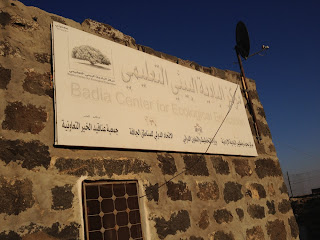
Last month I wrapped up a whirlwind 2-week trip to Doha, Qatar as part of a Portland State University study abroad program. After transferring to PSU in the fall from Lewis & Clark College, I've been excited about all of the opportunities here related to the Middle East. Three other students and three professors joined me in Doha for a course on "Qatar: Religion, Economy, and Sustainability." We were given lectures every day about various aspects related to Qatar, the Gulf, and the Middle East more generally.
After my trip last year to Dubai, going to Doha was a bit less shocking, since the two places are very similar. Both have been built pretty much from scratch in the past half-century, and are marked by rapid growth in population and physical scale. Both have very low populations of native citizens, and the rest are migrant workers who have come to cash in on the newfound wealth. Dubai may be more well-known internationally, but Doha is certainly climbing the ranks. Qatar currently holds the title of
richest country per capita, with an average income of over $88,000. Qatar is expected to become the first country in the world to surpass $100,000 in GDP per capital, reaching an astonishing
$113,000 by the year's end. The wealth here is apparent: cranes mark the skyline everywhere and massive projects are being constructed, including a new
"Heart of Doha" multipurpose project and a
giant medical research center. Construction has also begun on an array of soccer stadiums for the 2022 World Cup to be held in Doha, and plans are also underway for an extensive underground rail system.
One of the most popular, places to go for leisure in Doha is Souq Waqif, a traditional-style market near the corniche. The name translates from the Arabic as "Standing Market," which I'm told refers to the manner in which traders used to come stand in the souq and trade their goods. The
Qatar Tourism Authority calls Souq Waqif "the only traditional souq to remain in the Gulf" and "a showpiece of traditional architecture." The souq has been recently restored under the direction of the Emir of Qatar, and you can see the construction they are doing to expand the souq. The "Heart of Doha" project is also located right next to the souq, quite abruptly, and its massive scale stands in stark contrast to the traditional style of the souq. I'm skeptical of the name they've chosen to give this project--though in geographic terms it may be at the center of social activity, it seems to me that Souq Waqif is truly where the Heart of this city lies. Very little of the souq could actually be called "original," but you can see below an old and new picture of the main building that still stands, originally the Bismillah Hotel.
Souq Waqif is a unique place in Doha: it is one of few places where one can go to simply walk around outside (there was a park near the compound where we stayed for our trip, but it was always completely deserted). It is jam-packed in the evenings, staying busy until the wee hours of the morning. In the souq, locals and westerners rub elbows and observe each other, people come here to meet with friends, smoke hookah, and eat in the wide range of restaurants. The pictures below will give you a little tour of the Souq, which boasts restaurants of all different flavors, cafes, sweet shops, clothing traders, souvenir shops, and an animal and falcon market.
 A view of Souq Waqif in the 1970s
A view of Souq Waqif in the 1970s

The main alley of the souq today; cars are thankfully no longer allowed in the Souq, only the many pedestrians.
 The Bismillah Hotel in the 1970s
The Bismillah Hotel in the 1970s
 The (former) Bismillah hotel today
The (former) Bismillah hotel today

 A couple more views of the Souq today. There is a main street with cafes,
restaurants and shops; there are also many back streets and alleys with
other clothing, toy, spice and sweet shops--it's like a maze.
A couple more views of the Souq today. There is a main street with cafes,
restaurants and shops; there are also many back streets and alleys with
other clothing, toy, spice and sweet shops--it's like a maze.
A shop/mini-museum at the heart of the Souq. The owner of this little shop graduated from Portland State University in the 70s!

Selling traditional crafts
 Several camels live near the souq, next to an old fort
Several camels live near the souq, next to an old fort
 Camels, juxtaposed against the new "Heart of Doha" project in the background
Camels, juxtaposed against the new "Heart of Doha" project in the background
Future "Heart of Doha"
 Outside the souq.. traffic in Doha & a museum with a minaret resembling that of the Ibn Tulun Mosque in Cairo.
Outside the souq.. traffic in Doha & a museum with a minaret resembling that of the Ibn Tulun Mosque in Cairo.

Souq Waqif's animal market

Kitty for sale

And the falcon market

The marks of globalization... for sale in Souq Waqif: colorful shisha pipes, along with Bob Marley and Che Guevara busts... Baskin Robbins & Dunkin Donuts, ceramic incense burners resembling the national dress (made in China, of course)
Police "patrol" the streets of the Souq keeping it safe (but more for the show than anything)




































































